child seat PEUGEOT 108 2016 Owners Manual
[x] Cancel search | Manufacturer: PEUGEOT, Model Year: 2016, Model line: 108, Model: PEUGEOT 108 2016Pages: 268, PDF Size: 6.17 MB
Page 5 of 268
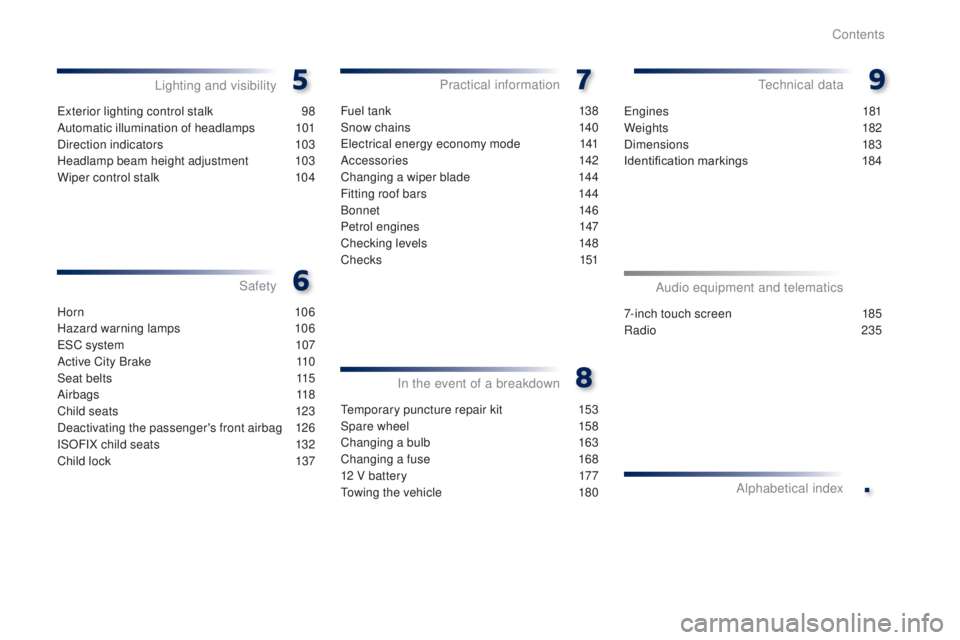
.
108_en_Chap00a_sommaire_ed01-2016
exterior lighting control stalk 98
Automatic illumination of headlamps
1
01
Direction indicators
1
03
Headlamp beam height adjustment
1
03
Wiper control stalk
1
04
Lighting and visibility
Horn 10 6
Hazard warning lamps
1
06
e
SC system
1
07
Active City Brake
1
10
Seat belts
1
15
Airbags
118
Child seats
1
23
Deactivating the passenger's front airbag
1
26
ISOFIX child seats
1
32
Child lock
1
37
SafetyIn the event of a breakdown
Fuel tank 1 38
Snow chains
1
40
el
ectrical energy economy mode
1
41
Accessories
142
Changing a wiper blade
1
44
Fitting roof bars
1
44
Bonnet
14
6
Petrol engines
1
47
Checking levels
1
48
C h e c ks
151
Practical informationte chnical data
7-inch touch screen 185
Radio
2
35
Audio equipment and telematics
Alphabetical index
temporary puncture repair kit 1 53
Spare wheel
1
58
Changing a bulb
1
63
Changing a fuse
1
68
12 V battery
1
77
to
wing the vehicle
1
80
en
gines
181
Weights
182
Dimensions
183
Identification markings
1
84
Contents
Page 7 of 268
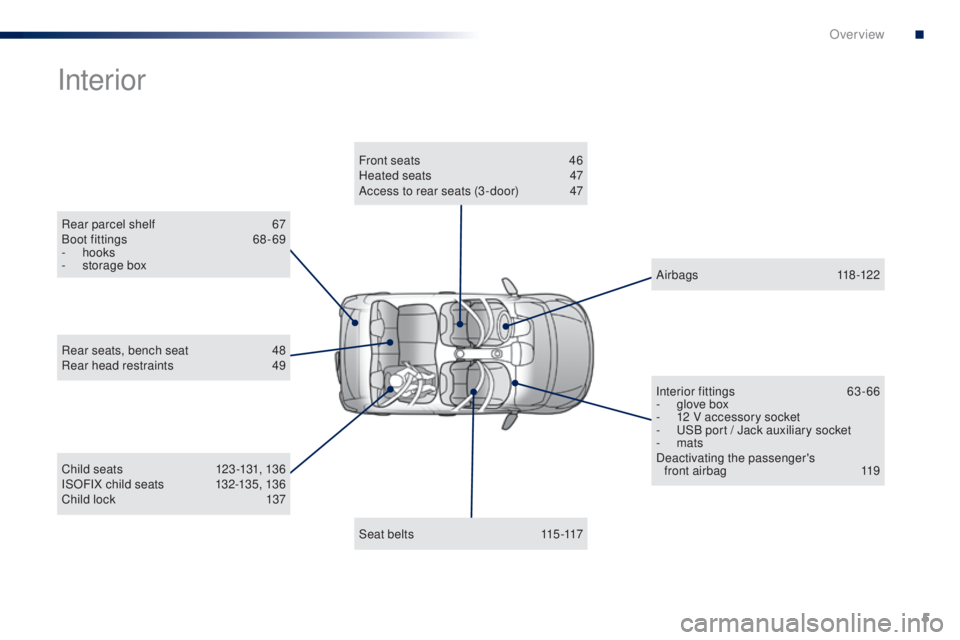
5
108_en_Chap00b_vue-ensemble_ed01-2016
Rear parcel shelf 67
Boot fittings 6 8 - 69
-
hooks
-
s
torage box
Interior
Child seats 1 23 -131, 136
ISOFIX child seats 1 32-135, 136
Child lock
1
37
Rear seats, bench seat
4
8
Rear head restraints
4
9
Interior fittings
6
3-66
-
g
love box
-
1
2 V accessory socket
- u
S
B port / Jack auxiliary socket
- mats
Deactivating the passenger's front airbag 1 19
Airbags
118-122
Seat belts
1
15-117
Front seats
4
6
Heated seats
4
7
Access to rear seats (3 -door)
4
7
.
Over view
Page 24 of 268
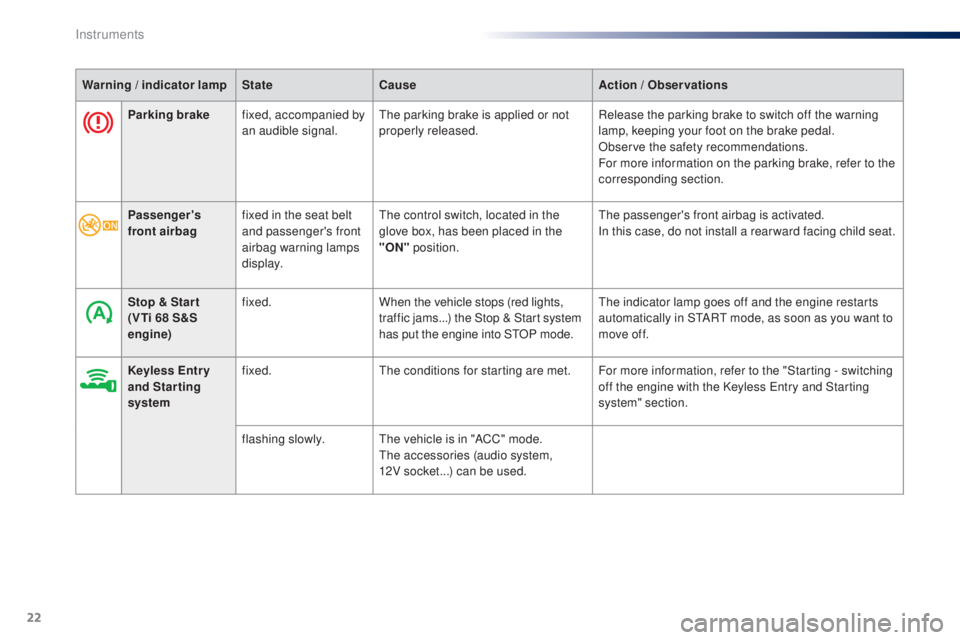
22
Parking brakefixed, accompanied by
an audible signal.th e parking brake is applied or not
properly released. Release the parking brake to switch off the warning
lamp, keeping your foot on the brake pedal.
Observe the safety recommendations.
For more information on the parking brake, refer to the
corresponding section.
Warning / indicator lamp
StateCause Action / o
b
servations
Passenger's
front airbag fixed in the seat belt
and passenger's front
airbag warning lamps
display.
th
e control switch, located in the
glove box, has been placed in the
"
o
N
" position.
the
passenger's front airbag is activated.
In this case, do not install a rear ward facing child seat.
Stop & Star t
(V
ti 6
8 S&S
engine) fixed.
When the vehicle stops (red lights,
traffic jams...) the Stop & Start system
has put the engine into S
tO
P mode.
th
e indicator lamp goes off and the engine restarts
automatically in S
tA
R
t
mode, as soon as you want to
move off.
Keyless
e
n
tr y
and Starting
system fixed.
th
e conditions for starting are met. For more information, refer to the "Starting - switching off the engine with the Keyless
e
n
try and Starting
system" section.
flashing slowly.
th
e vehicle is in "ACC" mode.
th
e accessories (audio system,
12V socket...) can be used.
Instruments
Page 26 of 268
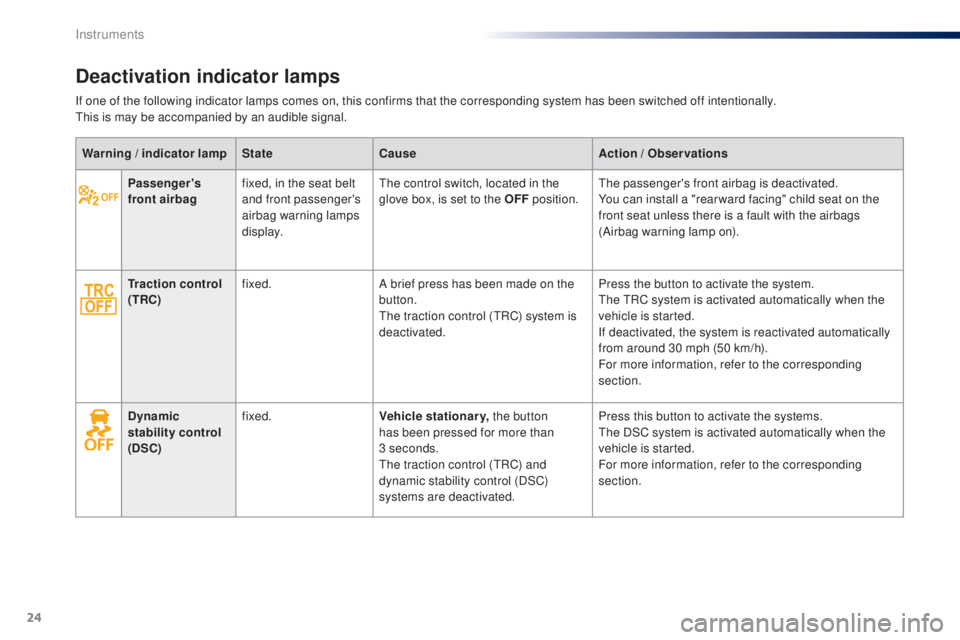
24
Passenger's
front airbagfixed, in the seat belt
and front passenger's
airbag warning lamps
display.th
e control switch, located in the
glove box, is set to the oFF p
osition.the passenger's front airbag is deactivated.
You can install a "rear ward facing" child seat on the
front seat unless there is a fault with the airbags
(Airbag warning lamp on).
tr
action control
(
tR
C) fixed.
A brief press has been made on the
button.
th
e traction control (
tR
C) system is
deactivated. Press the button to activate the system.
th
e t
R
C system is activated automatically when the
vehicle is started.
If deactivated, the system is reactivated automatically
from around 30 mph (50 km/h).
For more information, refer to the corresponding
section.
Dynamic
stability control
(DSC) fixed.
Vehicle stationary, the button
has been pressed for more than
3
seconds.
th
e traction control (
tR
C) and
dynamic stability control (DSC)
systems are deactivated. Press this button to activate the systems.
th
e DSC system is activated automatically when the
vehicle is started.
For more information, refer to the corresponding
section.
Warning / indicator lamp
StateCause Action / o
b
servations
Deactivation indicator lamps
If one of the following indicator lamps comes on, this confirms that the corresponding system has been switched off intentionally.th
is is may be accompanied by an audible signal.
Instruments
Page 43 of 268
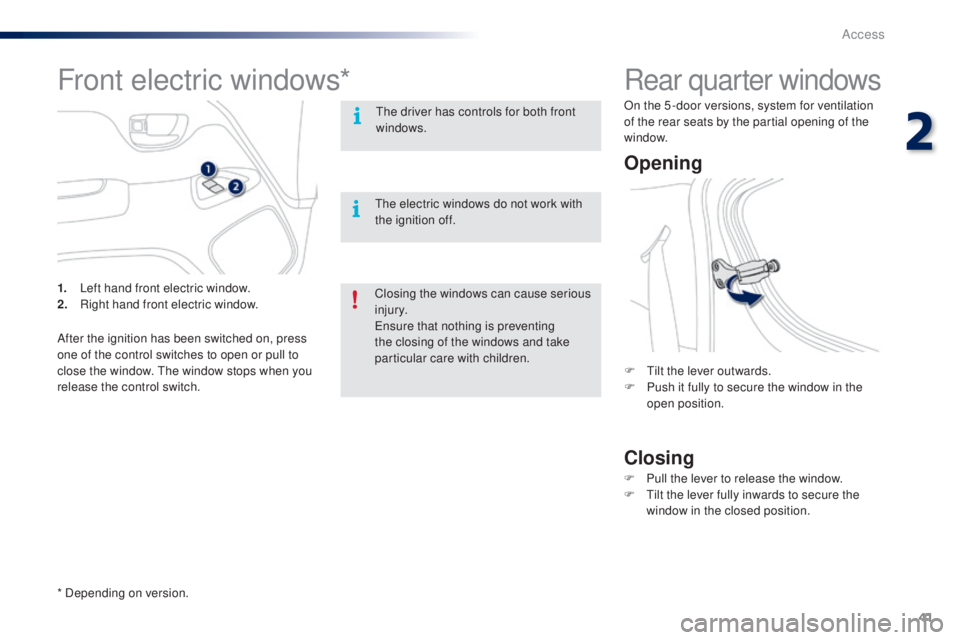
41
108_en_Chap02_ouvertures_ed01-2016
Rear quarter windows
opening
Closing
F tilt the lever outwards.
F P ush it fully to secure the window in the
open position.
F
P
ull the lever to release the window.
F
t
i
lt the lever fully inwards to secure the
window in the closed position.
On the 5 -door versions, system for ventilation
of the rear seats by the partial opening of the
window.
Front electric windows*
the driver has controls for both front
windows.
th
e electric windows do not work with
the ignition off.
1.
L
eft hand front electric window.
2.
R
ight hand front electric window.
After the ignition has been switched on, press
one of the control switches to open or pull to
close the window.
t
he
window stops when you
release the control switch.
* Depending on version. Closing the windows can cause serious
injury.
en
sure that nothing is preventing
the closing of the windows and take
particular care with children.
2
Access
Page 119 of 268
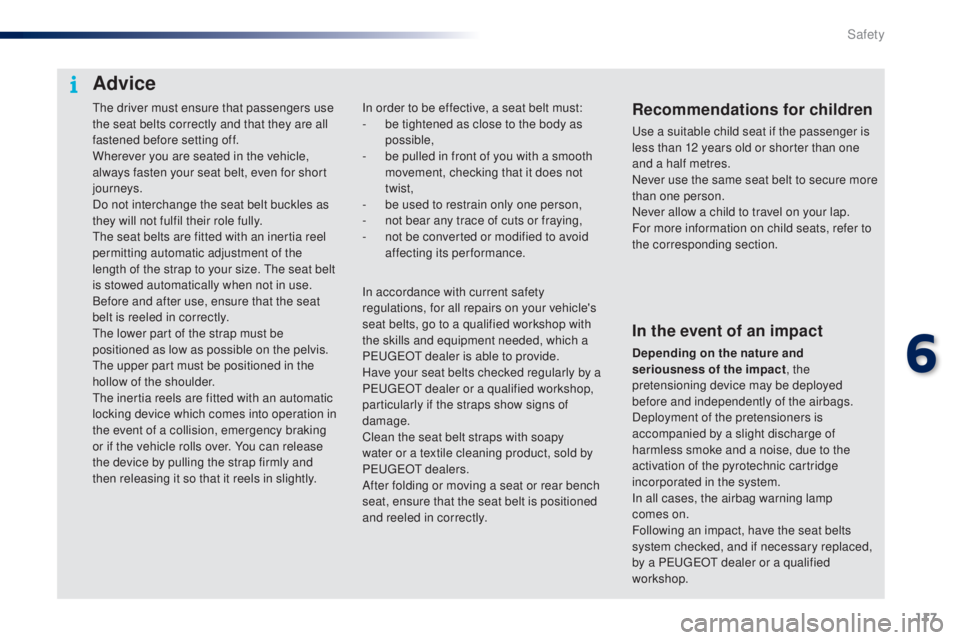
117
108_en_Chap06_securite_ed01-2016
the driver must ensure that passengers use
the seat belts correctly and that they are all
fastened before setting off.
Wherever you are seated in the vehicle,
always fasten your seat belt, even for short
journeys.
Do not interchange the seat belt buckles as
they will not fulfil their role fully.
th
e seat belts are fitted with an inertia reel
permitting automatic adjustment of the
length of the strap to your size.
t
h
e seat belt
is stowed automatically when not in use.
Before and after use, ensure that the seat
belt is reeled in correctly.
th
e lower part of the strap must be
positioned as low as possible on the pelvis.
th
e upper part must be positioned in the
hollow of the shoulder.
th
e inertia reels are fitted with an automatic
locking device which comes into operation in
the event of a collision, emergency braking
or if the vehicle rolls over. You can release
the device by pulling the strap firmly and
then releasing it so that it reels in slightly.Recommendations for children
use a suitable child seat if the passenger is
less than 12 years old or shorter than one
and a half metres.
Never use the same seat belt to secure more
than one person.
Never allow a child to travel on your lap.
For more information on child seats, refer to
the corresponding section.
In order to be effective, a seat belt must:
-
b
e tightened as close to the body as
possible,
-
b
e pulled in front of you with a smooth
movement, checking that it does not
twist,
-
b
e used to restrain only one person,
-
n
ot bear any trace of cuts or fraying,
-
n
ot be converted or modified to avoid
affecting its performance.
In the event of an impact
Depending on the nature and
seriousness of the impact , the
pretensioning device may be deployed
before and independently of the airbags.
Deployment of the pretensioners is
accompanied by a slight discharge of
harmless smoke and a noise, due to the
activation of the pyrotechnic cartridge
incorporated in the system.
In all cases, the airbag warning lamp
comes on.
Following an impact, have the seat belts
system checked, and if necessary replaced,
by a P
e
uge
Ot
dealer or a qualified
workshop.
In accordance with current safety
regulations, for all repairs on your vehicle's
seat belts, go to a qualified workshop with
the skills and equipment needed, which a
Pe
ugeOt d
ealer is able to provide.
Have your seat belts checked regularly by a
P
e
uge
Ot
dealer or a qualified workshop,
particularly if the straps show signs of
damage.
Clean the seat belt straps with soapy
water or a textile cleaning product, sold by
P
e
uge
Ot d
ealers.
After folding or moving a seat or rear bench
seat, ensure that the seat belt is positioned
and reeled in correctly.
Advice
6
Safety
Page 121 of 268
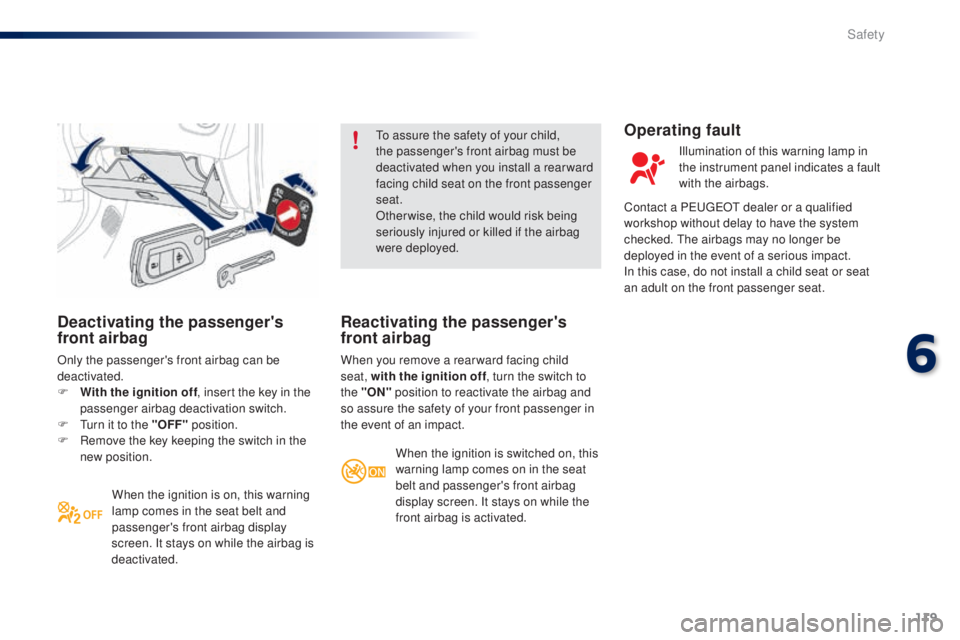
119
108_en_Chap06_securite_ed01-2016
Deactivating the passenger's
front airbag
Only the passenger's front airbag can be
deactivated.
F
W
ith the ignition off , insert the key in the
passenger airbag deactivation switch.
F
t
u
rn it to the "
oFF
" position.
F
R
emove the key keeping the switch in the
new position.
When the ignition is on, this warning
lamp comes in the seat belt and
passenger's front airbag display
screen. It stays on while the airbag is
deactivated.
to a
ssure the safety of your child,
the passenger's front airbag must be
deactivated when you install a rear ward
facing child seat on the front passenger
seat.
Otherwise, the child would risk being
seriously injured or killed if the airbag
were deployed.
Reactivating the passenger's
front airbag
When you remove a rear ward facing child
seat, with the ignition off , turn the switch to
the
" o
N
" position to reactivate the airbag and
so assure the safety of your front passenger in
the event of an impact.
When the ignition is switched on, this
warning lamp comes on in the seat
belt and passenger's front airbag
display screen. It stays on while the
front airbag is activated.
operating fault
Illumination of this warning lamp in
the instrument panel indicates a fault
with the airbags.
Contact a P
e
uge
Ot
dealer or a qualified
workshop without delay to have the system
checked.
t
h
e airbags may no longer be
deployed in the event of a serious impact.
In this case, do not install a child seat or seat
an adult on the front passenger seat.
6
Safety
Page 124 of 268
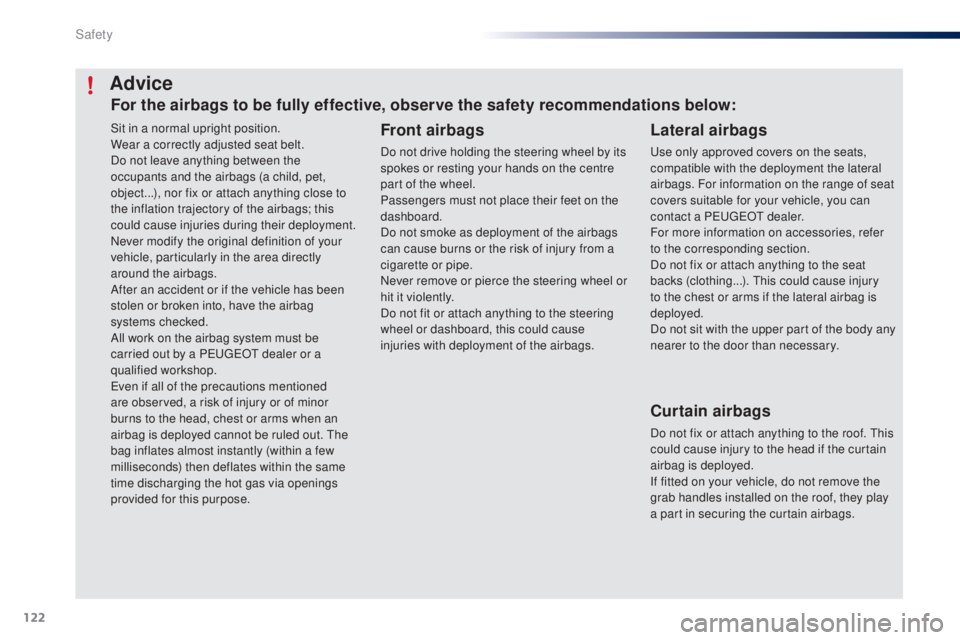
122
108_en_Chap06_securite_ed01-2016
Sit in a normal upright position.
Wear a correctly adjusted seat belt.
Do not leave anything between the
occupants and the airbags (a child, pet,
object...), nor fix or attach anything close to
the inflation trajectory of the airbags; this
could cause injuries during their deployment.
Never modify the original definition of your
vehicle, particularly in the area directly
around the airbags.
After an accident or if the vehicle has been
stolen or broken into, have the airbag
systems checked.
All work on the airbag system must be
carried out by a P
e
uge
Ot
dealer or a
qualified workshop.
ev
en if all of the precautions mentioned
are observed, a risk of injury or of minor
burns to the head, chest or arms when an
airbag is deployed cannot be ruled out.
t
h
e
bag inflates almost instantly (within a few
milliseconds) then deflates within the same
time discharging the hot gas via openings
provided for this purpose.Front airbags
Do not drive holding the steering wheel by its
spokes or resting your hands on the centre
part of the wheel.
Passengers must not place their feet on the
dashboard.
Do not smoke as deployment of the airbags
can cause burns or the risk of injury from a
cigarette or pipe.
Never remove or pierce the steering wheel or
hit it violently.
Do not fit or attach anything to the steering
wheel or dashboard, this could cause
injuries with deployment of the airbags.
Advice
Lateral airbags
use only approved covers on the seats,
compatible with the deployment the lateral
airbags. For information on the range of seat
covers suitable for your vehicle, you can
contact a P
e
uge
Ot
dealer.
For more information on accessories, refer
to the corresponding section.
Do not fix or attach anything to the seat
backs (clothing...).
t
h
is could cause injury
to the chest or arms if the lateral airbag is
deployed.
Do not sit with the upper part of the body any
nearer to the door than necessary.
Curtain airbags
Do not fix or attach anything to the roof. th is
could cause injury to the head if the curtain
airbag is deployed.
If fitted on your vehicle, do not remove the
grab handles installed on the roof, they play
a part in securing the curtain airbags.
For the airbags to be fully effective, observe the safety recommendations below:
Safety
Page 125 of 268
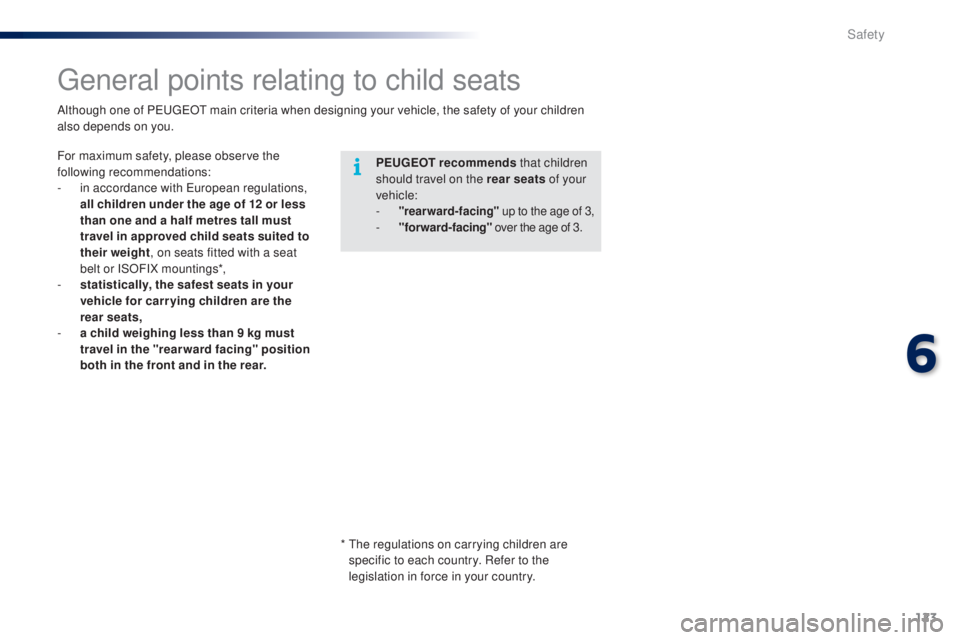
123
108_en_Chap06_securite_ed01-2016
general points relating to child seats
Peugeot recommends that children
should travel on the rear seats of your
vehicle:
-
"rearward-facing" up to the age of 3,- "forward-facing" over the age of 3.
Although one of P
e
uge
Ot
main criteria when designing your vehicle, the safety of your children
also depends on you.
For maximum safety, please observe the
following recommendations:
-
i
n accordance with
e
u
ropean regulations,
all children under the age of 12 or less
than one and a half metres tall must
travel in approved child seats suited to
their weight , on seats fitted with a seat
belt or ISOFIX mountings*,
-
s
tatistically, the safest seats in your
vehicle for carr ying children are the
rear seats,
-
a c
hild weighing less than 9 kg must
travel in the "rear ward facing" position
both in the front and in the rear.
*
t
h
e regulations on carrying children are
specific to each country. Refer to the
legislation in force in your country.
6
Safety
Page 126 of 268
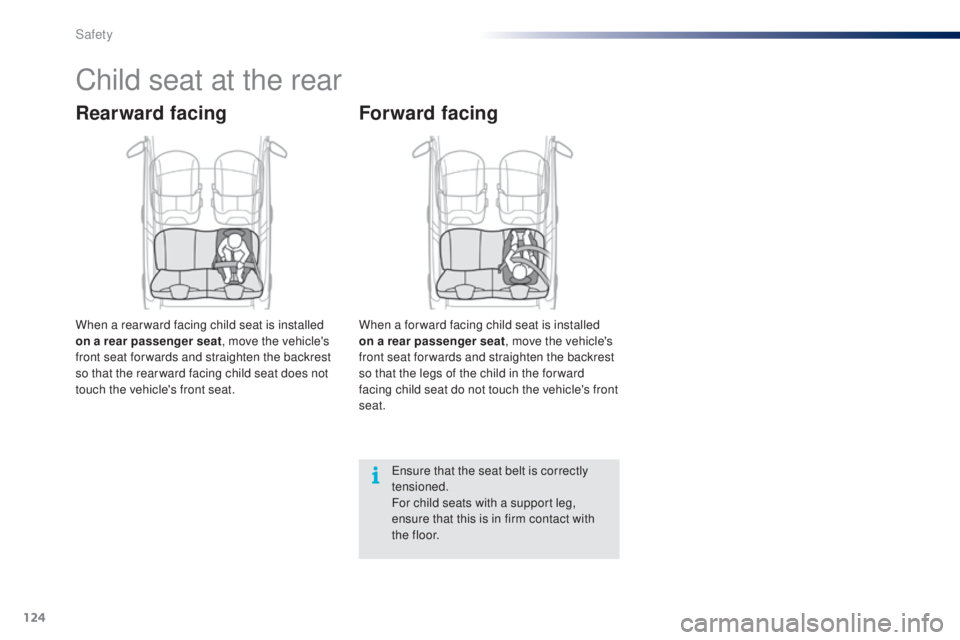
124
108_en_Chap06_securite_ed01-2016
Child seat at the rear
Rearward facing
When a rear ward facing child seat is installed
on a rear passenger seat, move the vehicle's
front seat for wards and straighten the backrest
so that the rear ward facing child seat does not
touch the vehicle's front seat.
Forward facing
When a for ward facing child seat is installed
on a rear passenger seat , move the vehicle's
front seat for wards and straighten the backrest
so that the legs of the child in the for ward
facing child seat do not touch the vehicle's front
seat.
en
sure that the seat belt is correctly
tensioned.
For child seats with a support leg,
ensure that this is in firm contact with
t h e f l o o r.
Safety